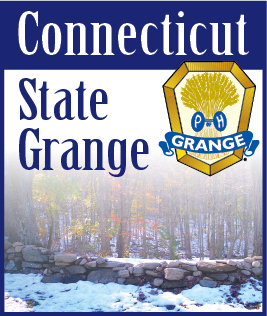| APRIL 10, 2013 -- The following is the second part of a series on Harmony Grange No. 92, Patrons of Husbandry. April is Grange Month. Harmony Grange's members live in Trumbull, Shelton and Monroe.
Crops on James Burr's farm included tobacco, along with vegetables like asparagus, peas, potatoes and turnips. Among the fruit growing on his family's Elm Street property were grapes, apples, peaches and plums. But the strawberry harvest proved to be the cash cow in the late 1800's, according to town historian Edward Coffey's book, "A Glimpse of Old Monroe."
According to the U.S. Census, 994 people lived in Monroe in 1890.
"Everyone was a farmer," said Nancy Zorena, a member of the Monroe Historical Society, adding residents practiced other trades during the winter.
Produce was delivered along dirt roads by horse and buggy and by train. The Housatonic Railroad made its first stop in Stepney on its way from Bridgeport to New Milford in 1840 and the Berkshire Line of the Derby Extension first ran through Stevenson in 1888, according to Zorena.
In 1889, town farmers decided to organize and share ideas about their occupation. The group met at Monroe Congregational Church on Jan. 18 for the first meeting of the Harmony Grange, which would become the 92nd Grange in Connecticut.
On that night, a vote of thanks was given to Brother Blake of the Housatonic Grange in Stratford for helping Monroe to get it's grange up and running.
Harmony Grange adopted the Housatonic Grange's bylaws before finalizing its own.
Ronald Bunovsky, current vice president of Harmony Grange, said the minutes of the first meeting were found, handwritten in a book at the bottom of a filing cabinet in the white grange building at 2 Shelton Road.
What's the Password?
Only members are allowed to attend grange meetings. Before anyone is allowed through the door, Bunovsky said a secret password had to be given, adding this was a way to protect the farmers' interests. Some granges no longer require a password, while others, like Harmony Grange still honor the tradition.
A dozen people attended the first meeting, during which three officers were installed. James Burr was elected as Master, E.G. Beardsley as Secretary and Eleanor S. Burr was appointed Pamona.
Gail Bunovsky, who is a current grange member and Ronald's wife, said a pamona tends to the needs of the sick and ensures recognition for grange members at funerals.
Harmony Grange's membership steadily grew during its early years. In 1891 there were 28 members, by 1893 there were 67 and by 1895 membership stood at 75.
"They exchanged information on how to deal with insects and pests and on crop rotation," Ronald Bunovsky said of some of the issues meetings covered. "They were always looking for the biggest bang for their buck in farming."
Subordinate granges throughout Connecticut contribute to government resolutions to make the lives of farmers better, said Bunovsky.
According to the Connecticut State Grange website, "All Grange activities are for the purpose of developing leadership, improving community life, and expanding opportunities for all people."
Among the different types of granges are The Junior Grange for children from age 5 to 14, The Subordinate Grange — which Harmony Grange is, The Pomona Grange (equivalent to a countywide, regional grange), The State Grange and The National Grange.
Music and Dancing
During the early years of Harmony Grange, weary farmers could read after a long day of working in the fields or search the radio dial for a station with good reception to unwind. Television was a long way off.
Going out on the town often meant coming to the local grange to listen to live music, dance, watch plays and mingle with neighbors over potluck dinners.
Harmony Grange has a dance floor, a piano and a stage on the upper level.
Ronald Bunovsky said, "Those people were just looking to leave the drudgery of the farm and it provided that social outlet — and a place to discuss the concerns of farmers."
For information on Harmony Grange No. 92 or to be a member, call its president, George Ward at 203-929-3171. |
